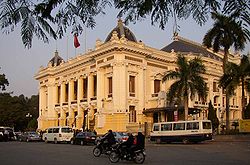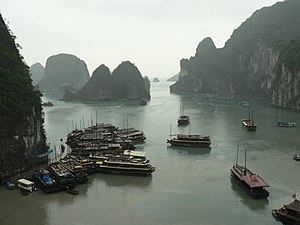The Socialist Republic of Vietnam is a country in Southeast Asia. It borders China, Laos, Cambodia, and the Gulf of Tonkin. It has a population of over 85 million and a land mass of 329,560 km² Vietnam is a poor, densely populated country that has had to recover from the ravages of war, the loss of financial support from the old Soviet bloc, and the rigidities of a centrally planned economy.

We visited North Vietnam in April 2007 on a 5 days tour to Hanoi and Halong Bay, with one day stop in Cat Ba Island. Most of Hanoi's few high-rise buildings were hotels (tallest was 26 floors), most housing are narrow but up to six stories tall (each floor is generally occupied by different families) and there is no zoning as old run down buildings can be found next to new buildings in all parts of town. The principal mode of transportation is mopeds and small motorcycles, except for the many tour buses. While the streets were dusty, they were normally free of litter. It appears that most residents eat at small sidewalk "restaurants" where the limited food is cooked and dishes washed on the sidewalk. Vietnam has no major highway system, even in and around Hanoi, so bus travel was slow which allowed us to view the city streets, village neighborhoods and countryside much better.
Hanoi
A visit to Hanoi, Vietnam is stepping back in time, somewhat reminiscent of Beijing in the early 1980's. Signs of French occupation in housing is still apparent, and their war memorials and art galleries give testament to the long wars that ravaged the country. Yet the spirit of its people, the daily life show the eternal hope and give promise to what long-lasting peace can bring this wonderful country.

Image Source: Wikipedia
Hanoi, with a population of 3,500,000, is the capital of Vietnam . The city is located on the right bank of the Red River. Hanoi became the capital of the Vietnam in the 7th century. Its Chinese-derived name, Đông Kinh, became Tonkin and was applied by Europeans to the entire region. Hanoi was occupied by the French in 1873 and passed to them ten years later. It became the capital of French Indochina after 1887.
The city was occupied by the Japanese in 1940, and liberated in 1945, when it became the seat of Vietnam's government. From 1946 to 1954, it was the scene of heavy fighting between the French and Viet Minh forces. At that point, the city became the capital of an independent North Vietnam.
During the Vietnam War Hanoi's transportation facilities were disrupted by the bombing of bridges and railways, which were, however, immediately repaired. Following the end of the war Hanoi was established as the capital of the Socialist Republic of Vietnam when North and South Vietnam were united on July 2, 1976.
Source: Wikipedia.org
Halong Bay
Halong Bay, located on the coast of Vietnam in the Gulf of Tonkin is one of the most spectacular photographic sites in SE Asia. The Bay consists of almost 2,000 islands, topped with thick jungle vegetation rising spectacularly from the ocean. Some are home to Vietnamese fisherman, others contain enormous caves. It is a World Heritage site, and one of Vietnam's most popular tourist destinations.
You can tell that it is a popular place from the many tourist boats in the harbour and on the water. It is crowded but magnificent. I just wished we could have gone past the tourist ships and into the open waters.
People were poor but quite friendly. It was a enjoyable trip, even though the only day we even saw clouds was the day in Halong Bay and even then the weather was disappointing photography wise.


 Image Source:
Image Source: 